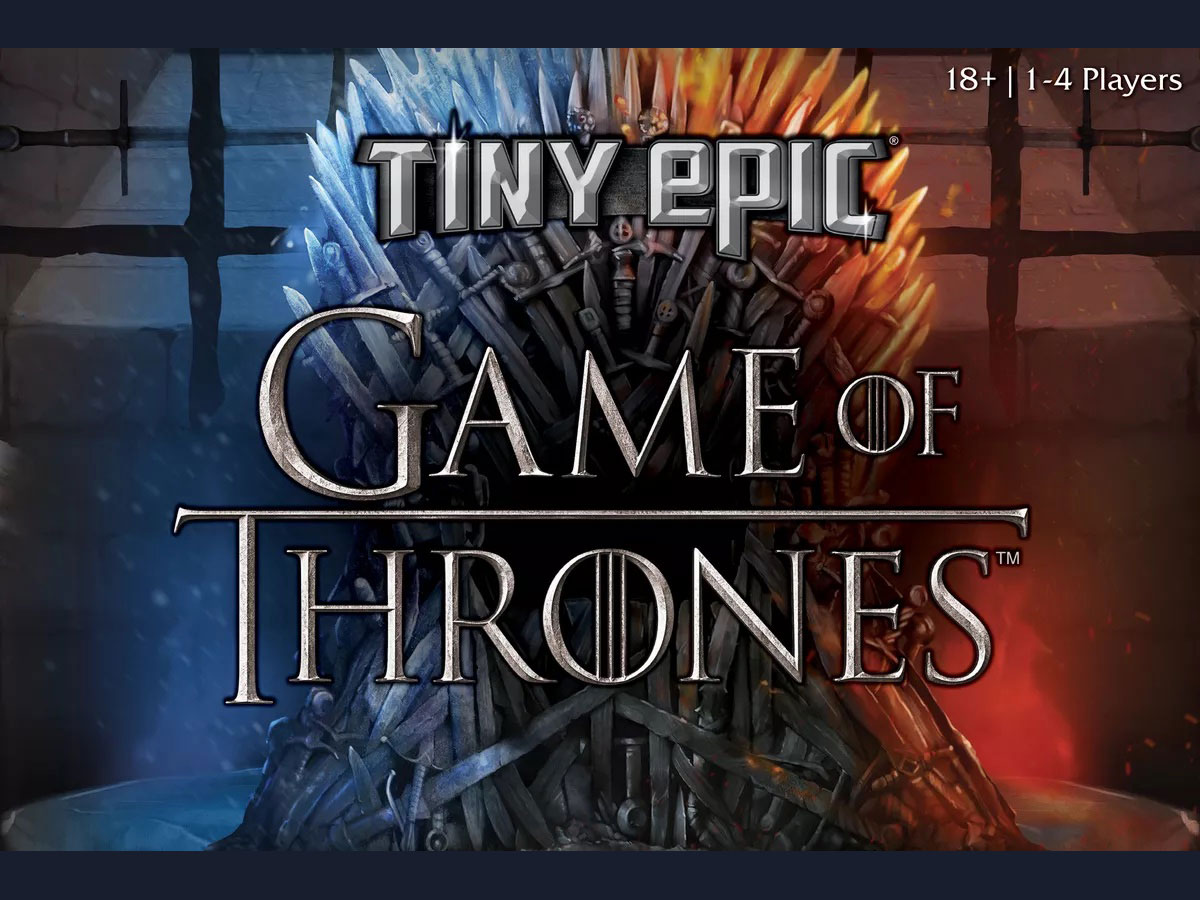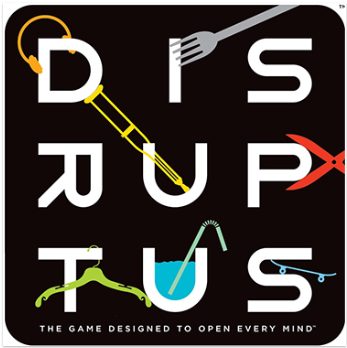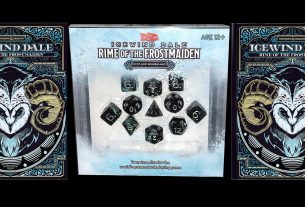Political maneuvering, shaky alliances, and inevitable betrayals, all in a box smaller than the first volume of A Game of Thrones.
What Is Tiny Epic Game of Thrones?
Tiny Epic Game of Thrones is an area-control game for 1 to 4 players, ages 18 and up, and takes about 60 minutes to play. Well, according to the box, anyway: my play times have usually lasted a bit longer than that though these have usually included teaching it. The 18+ is primarily for the game’s content rather than the gameplay; although there are allusions to the horrors of the book/show, nothing in the game is particularly explicit. It’s currently seeking funding on Kickstarter, with a pledge level of $40 for a copy of the game; for $45 you’ll get the Ice & Fire expansion that includes cooperative mode, and for $50 there’s an additional hero pack on top of that.
Tiny Epic Game of Thrones was designed by Scott Almes and co-published by Gamelyn Games and The Op, with illustrations by Nikoletta Vaszi.
New to Kickstarter? Check out our crowdfunding primer.

Tiny Epic Game of Thrones Components
Note: My review is based on a prototype copy, so it is subject to change and may not reflect final component quality. In particular, the prototype includes a lot of generic wooden components which will be replaced by custom printed meeples.
Here’s what comes in the base game box:
- 6 Map mats
- Action mat
- Score mat
- Round mat
- 45 Plot cards
- 8 House mats
- 7 Hero cards
- 7 Hero miniatures
- 72 Power tokens (9 each per house)
- 8 Shield tokens (1 per house)
- 4 Gold coins
- 12 Castles
- Iron Throne token
- Hand of the King token
- 2 Vengeance tokens
- Crown token
- 12 Rival cards (for solo game)
- 7 Solo Hero cards (for solo game)
- 5 Action dice
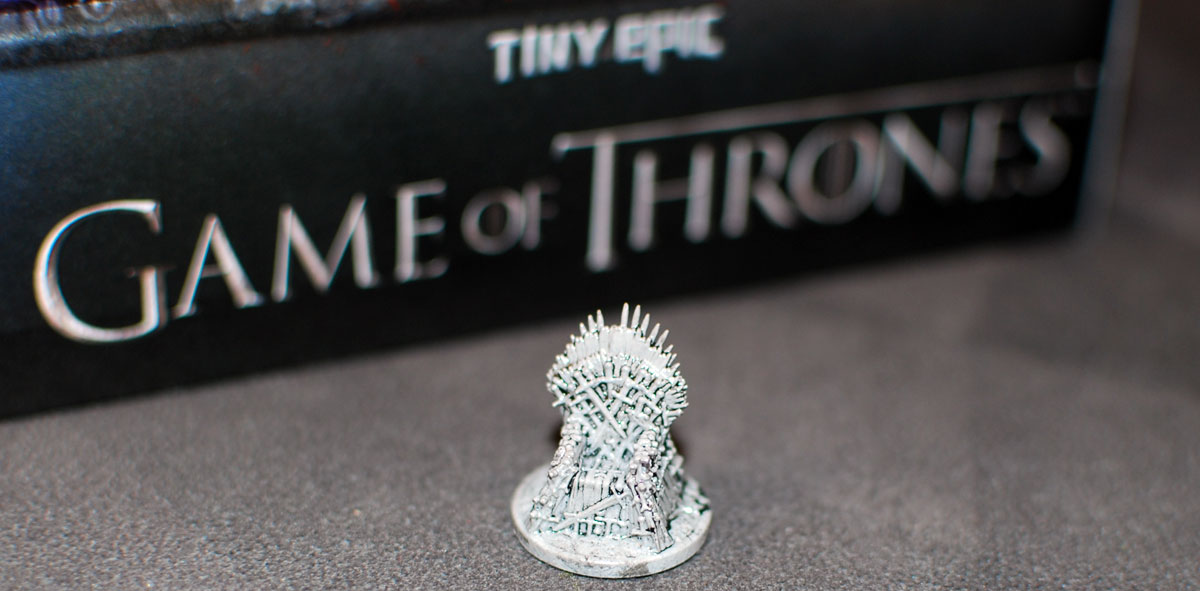
The Kickstarter version will be the deluxe edition, and also includes Tyrion Lannister as a bonus hero, as well as an Iron Throne miniature that can replace the wooden token in the retail edition.
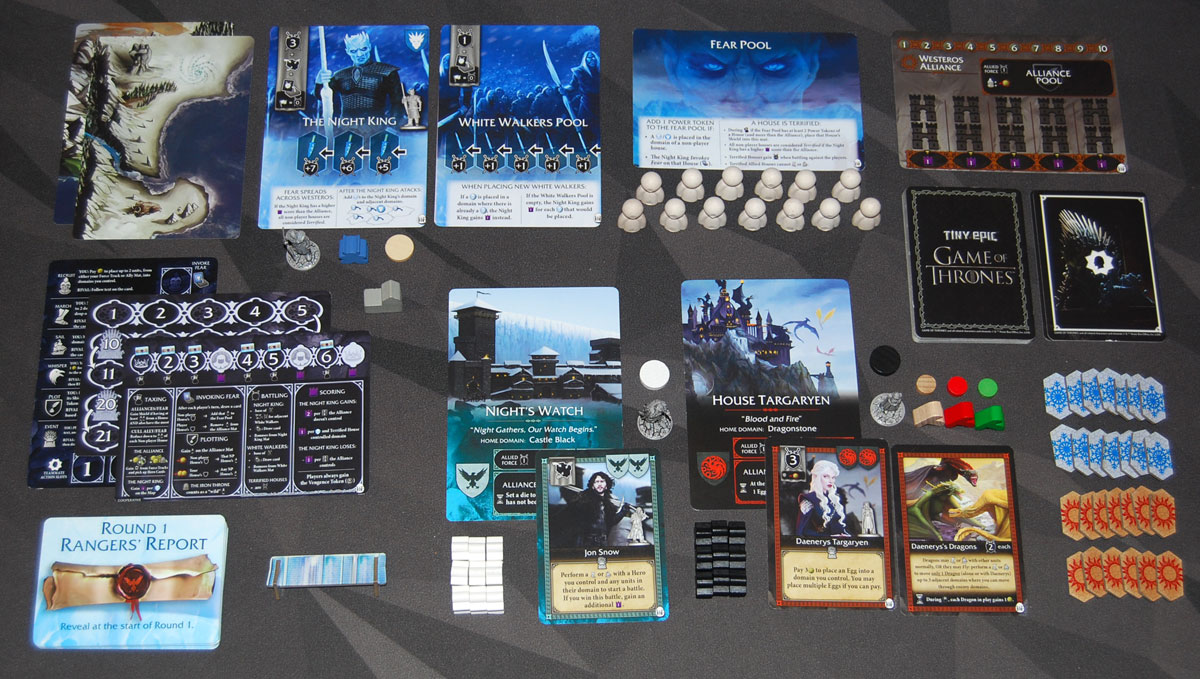
The bulk of my review will focus on the base game, but I’ll also touch on the cooperative game as well, so here’s what’s included in the Ice & Fire expansion:
- 2 Map mats
- Alliance mat
- Fear mat
- Action mat
- Round mat
- Night King mat
- White Walker mat
- Night King miniature
- Night King shield
- 13 White Walkers
- 28 Exploration tokens
- 18 Ranger cards
- Ice Dragon
- Ice Dragon card
- Castle
- Wall construct
- 17 Plot cards
- 2 House mats
- 2 Hero cards
- 2 Hero miniatures
- 18 Power tokens (9 per house)
- 2 Shield tokens (1 per house)
- 3 Dragon Eggs
- 3 Dragons
- 2 Solo Hero cards (for solo game)
The Heroes Pack will include 7 more heroes, each with a miniature, hero card, and solo game hero card—these can be substituted for the heroes in the base game as desired.
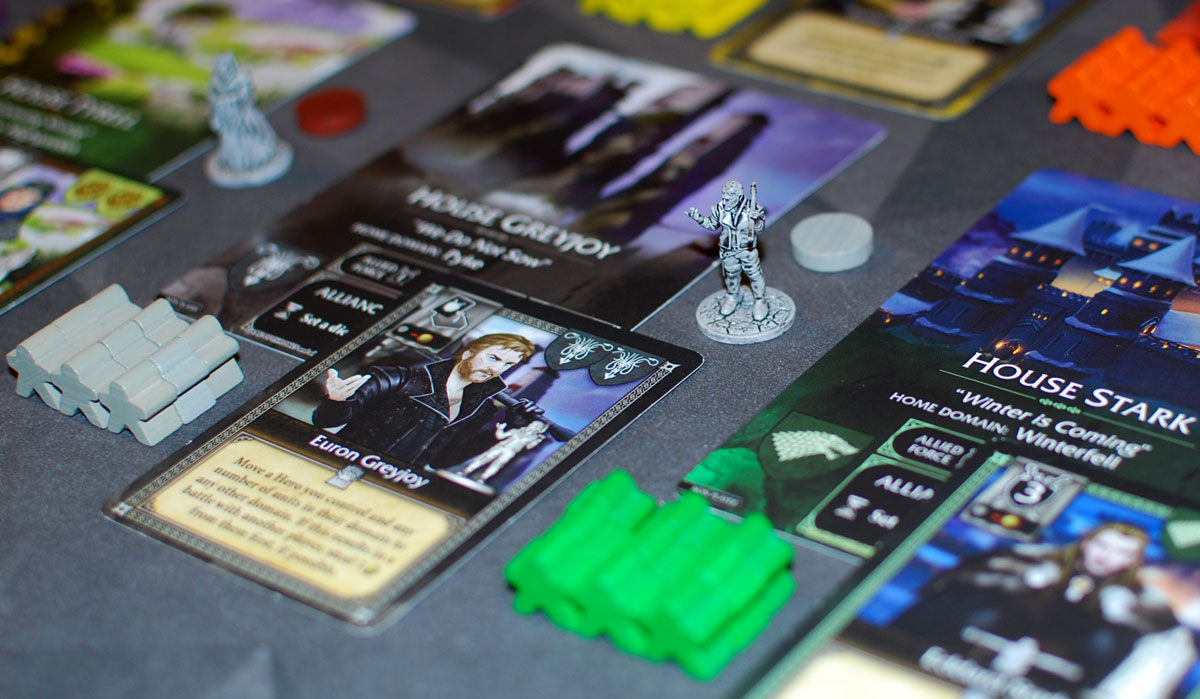
Each House includes a large house mat, 9 power tokens (meeples), a shield token, a hero card, and a hero miniature. The miniatures—sculpted by Jason Wiebe—are in 24mm scale and are pretty impressive. I believe this is only the second time that a Tiny Epic game has included plastic miniatures (after Tiny Epic Dungeons). (The exception is House Arryn, which cannot be used as a player and does not have a hero.)
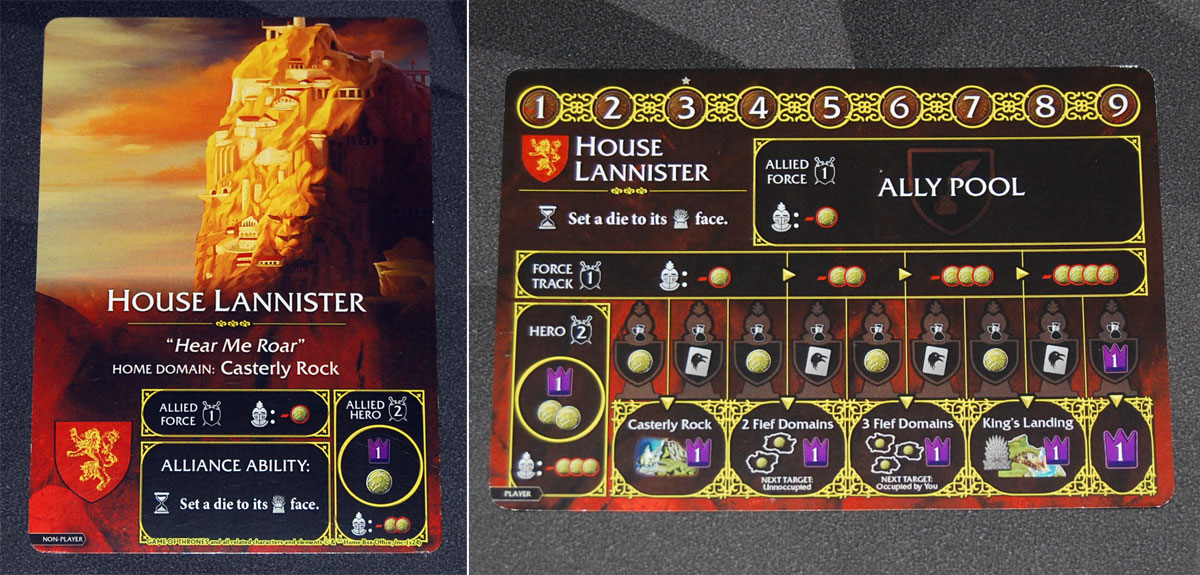
The house mats are oversized cards—one side is mostly an illustration and is used when that house is a non-player; the other side is used when a player chooses that house and has a lot more information and spaces to place the power tokens.
The map cards are also oversized cards, marked with directions so you can assemble the six into one large map of Westeros, with various lines dividing up the land into the different regions. There are a lot of little details on the map, as well as game iconography. It ends up being a decent-sized map, though still smaller than a typical board from a bigger game. Between the map and the various other mats, though, Tiny Epic Game of Thrones will still take up about the same amount of table space as many full-sized games.
I always talk about how much is packed into these tiny boxes, but this one feels like it’s really pushing the bounds of what can be packed inside. There are no half-sized cards this time: all the plot cards and hero cards are full-sized. The exact size and shape of a lot of the components will change in the final version (I imagine the dice will be smaller engraved dice rather than the large stickered dice in the prototype) but no matter what it’s an impressive spread of components, fitting for the sprawling story of Game of Thrones.
How to Play Tiny Epic Game of Thrones
You can download a draft of the base game rulebook here and the Ice & Fire rulebook here. I’ll talk about the regular (competitive) game first, and then explain how the cooperative game differs.
The Goal
The goal of the game is to score the most points in 6 rounds.

Setup
The map is assembled from the six large cards, and then the three common mats—score track, actions, and round tracker—are placed nearby. Add castles to all of the locations with castles, and the Iron Throne in the King’s Landing region. There are always 4 non-player houses including House Arryn: for each of these, place 3 power tokens in their home region, and the rest of the power tokens on the house mat, along with the shield and hero miniature, with the hero card nearby. (Arryn does not have a hero.)
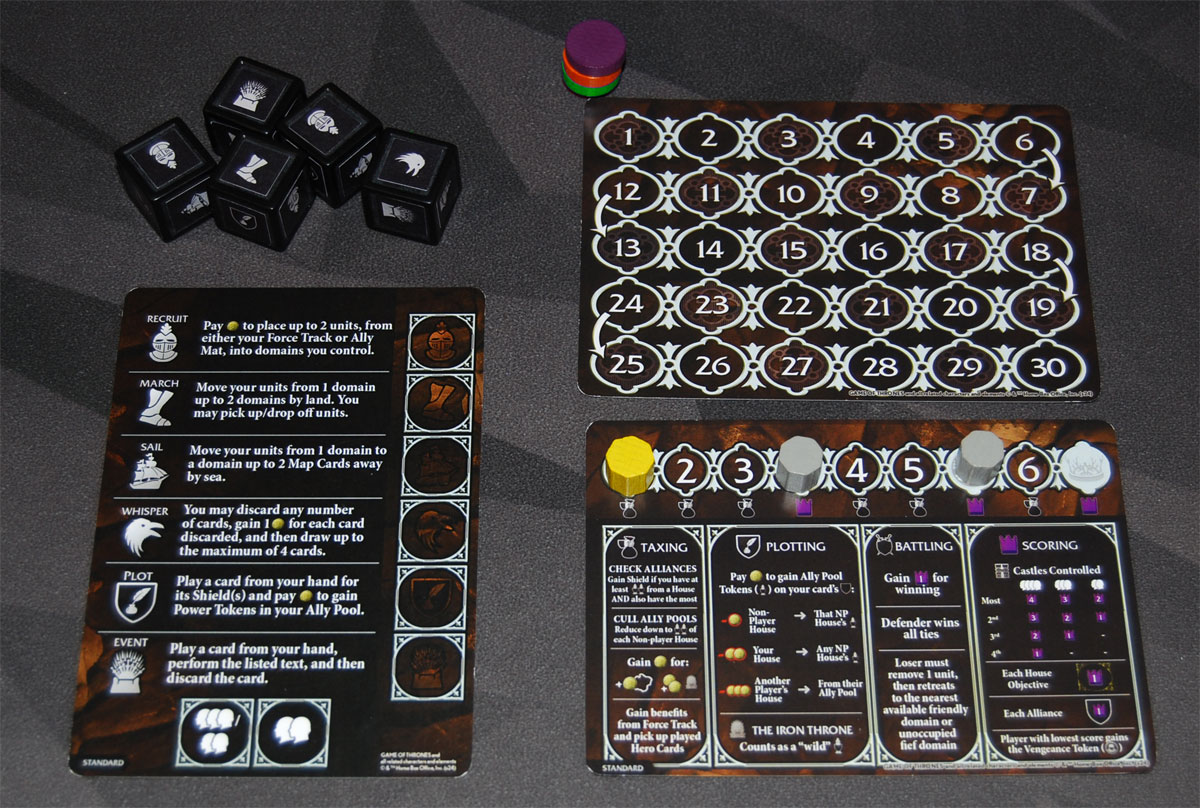
On the three main mats, you just need to place the crown on the starting round, and place the two vengeance tokens on the spaces after round 3 and round 5. Set the player shields next to the scoring mat, and the dice nearby.
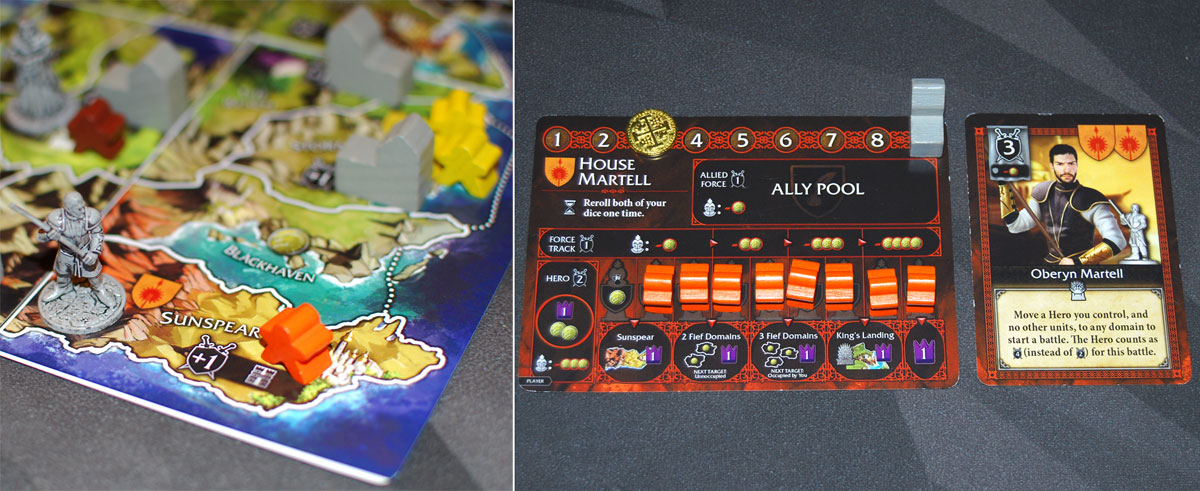
Each player chooses a house and takes the corresponding components. The house mat is flipped to the player side, and the player starts with 3 gold (the gold coin on the track at the top). Place the hero and one power token in the home region, and then take the castle from that region and place it on the “9” on the gold track. The rest of the power tokens are placed on the house mat, filling the rest of the track. Everyone also draws 4 cards from the plot deck and adds their hero card to their hand.
Choose a starting player and give them the Hand of the King token.
Gameplay
First, an important concept about alliances: the four non-player houses have troops on the map at the beginning, and although they won’t move around, they will defend their regions if you try to enter. However, you can make alliances with these houses by putting their power tokens in your ally pool—if you have an alliance, then any of that house’s power tokens and heroes on the map count as yours and you can move them around, recruit more, and so on. But be warned: if you lose an alliance, then you’ll get kicked out of any regions you were sharing with that house! You do not form alliances with other players and never take any of their power tokens.
Every round, players will choose actions based on the available dice. The first player rolls all the dice, and then players will draft dice in reverse turn order, leaving the first player with 2 dice. (When you have fewer than 4 players, some dice will also be chosen and placed at the bottom of the action mat.) Most of the houses also give you the ability to change a die to a particular face, so you can use that during your turn.
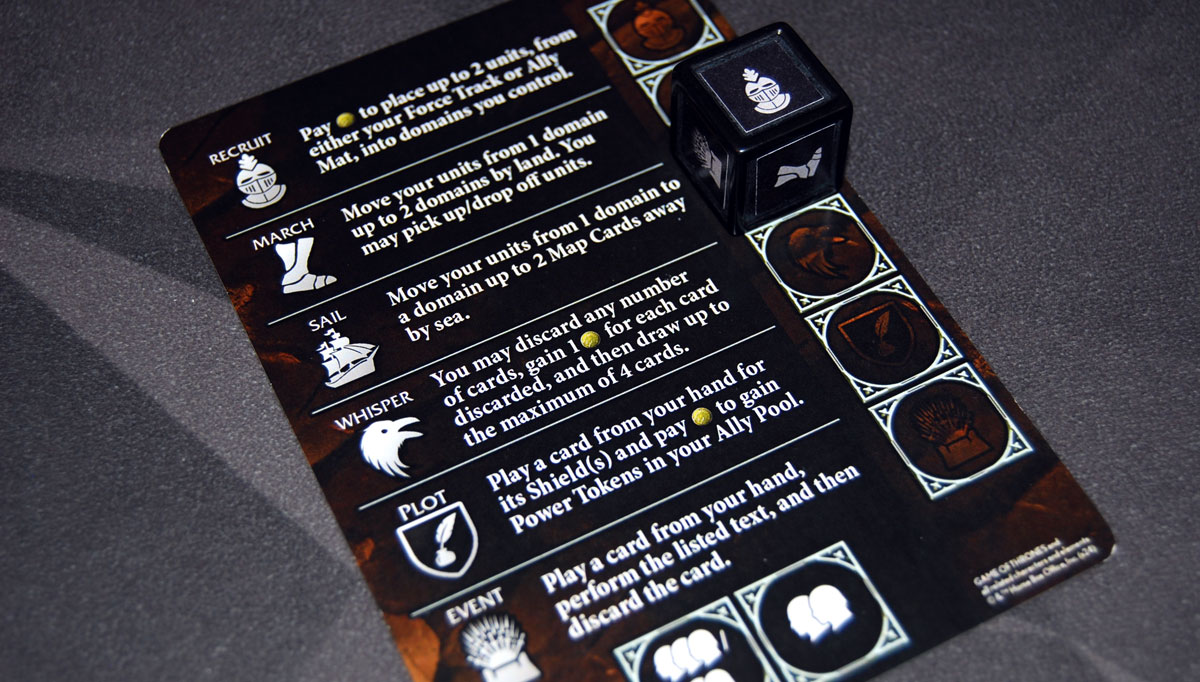
When it’s your turn, you choose one of two dice to place on the action mat (on an empty space), and then pass the unplaced die to the next player. Placing the die does two things: first, you get to take the action listed on the mat itself. Then, all players get to take the action of the die you placed.
In brief, the six actions (both on the mat and on the dice) are:
- Recruit: pay gold to add heroes or power tokens to the mat—the cost of your own increases as you have more of them; if you have allies, you may also pay to recruit power tokens from those houses as well. You may recruit 2 units per action.
- March: move units from one domain up to 2 spaces away.
- Sail: move units from one domain to any domain up to 2 map cards away. (You can’t sail around the north of the map.)
- Whisper: discard cards to get gold, and then draw back up to your hand size of 4.
- Plot: play a card and use the shields on it to gain power tokens for your ally pool—more details on this below.
- Event: play a card and use the event at the bottom.
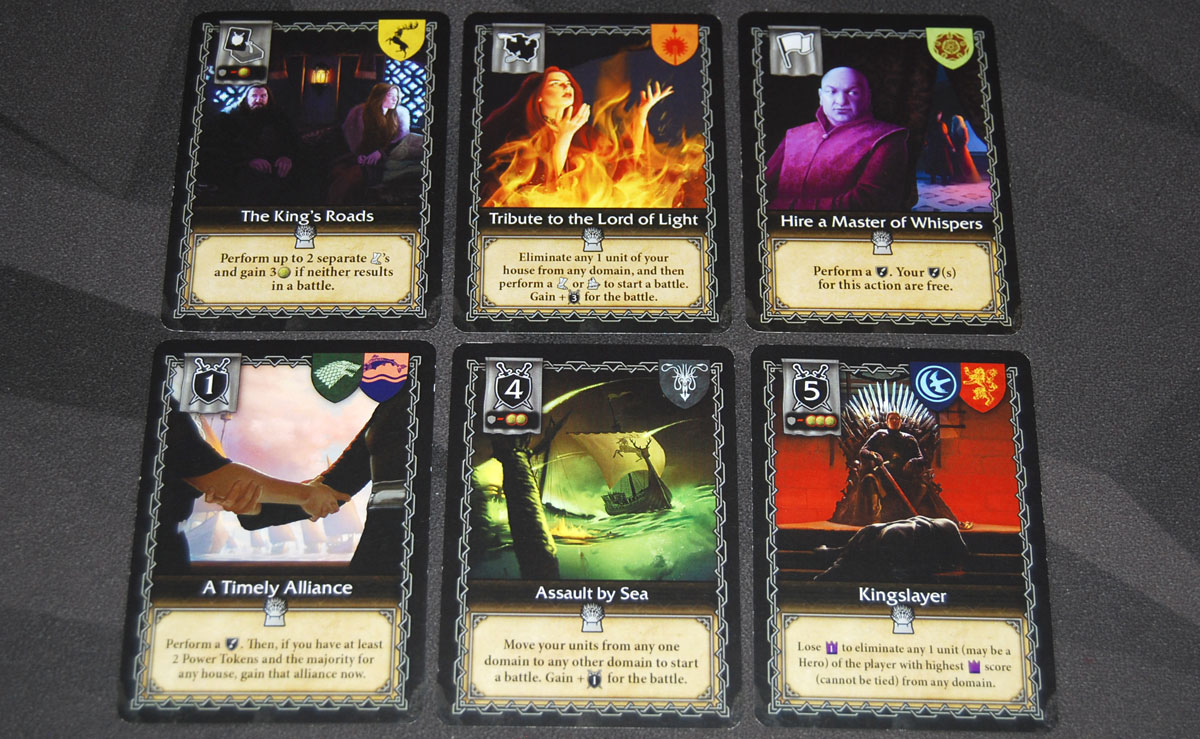
Plotting is one of the key ways to make alliances. Every card has 1 or 2 shields at the top: they may belong to you, another player, or one of the non-player houses (or a house that isn’t in the current game), and you will spend gold to take power tokens and put them in the ally pool on your house mat. For non-player houses, you pay 1 gold and take from the matching house. For your own shields, you pay 2 gold and take from any house. For an opponent’s shield, you pay 3 gold and steal a power token from their ally pool into your own. Alliance status is only checked at the end of the round, though, so things don’t change immediately when you take power tokens.

The number of units in any region is limited—you can have 3 of your own house, and up to 3 units of one allied house. (The non-player houses may ally with you, but never each other, so they can’t share a space.) If you ever enter a space—whether by marching or sailing—that is occupied by any units that aren’t your allies, you must stop and battle.
Battles are fairly simple: power tokens are worth 1 strength and heroes are worth 2. Castles provide 1 strength to the defender. In addition, each side may play one card toward the battle—attackers play cards for free, and defenders must pay the coin cost if any. (Non-player houses just flip the top card of the deck without paying.) Some cards will add from 1 to 5 strength, but there are also cards that will let you retreat for free, conscript to add the value of all of your units in neighboring regions, or even play the top card of the deck for free.
The player with the higher strength wins and gets 1 point, with attackers winning ties. The loser loses one power token from the battle—if any of them were non-player tokens, then that’s the one that gets lost, and it goes into the winner’s ally pool. (If you can’t protect your allies, they start thinking about changing teams!) Otherwise, the loser’s unit goes back onto their own player mat, where they will earn the consolation prize shown on the corresponding space. The rest of the loser’s units must retreat into the nearest space where they can stop without triggering a battle (though they can travel through enemy regions while retreating).
As you gain control of regions with castles, you take the castles and place them on your gold track. Castle upkeep is expensive! The more castles you have, the lower your maximum gold. If you ever abandon a region with a castle, take it off your gold track and put it back on the map.
King’s Landing is a special region—the iron throne provides 2 strength to the defender, and you are not even allowed to enter King’s Landing unless you have at least 3 castles. If you are in King’s Landing and you lose castles, you can get kicked out. The Iron Throne is also good for alliances—it counts as one of each non-player power token when calculating alliances.
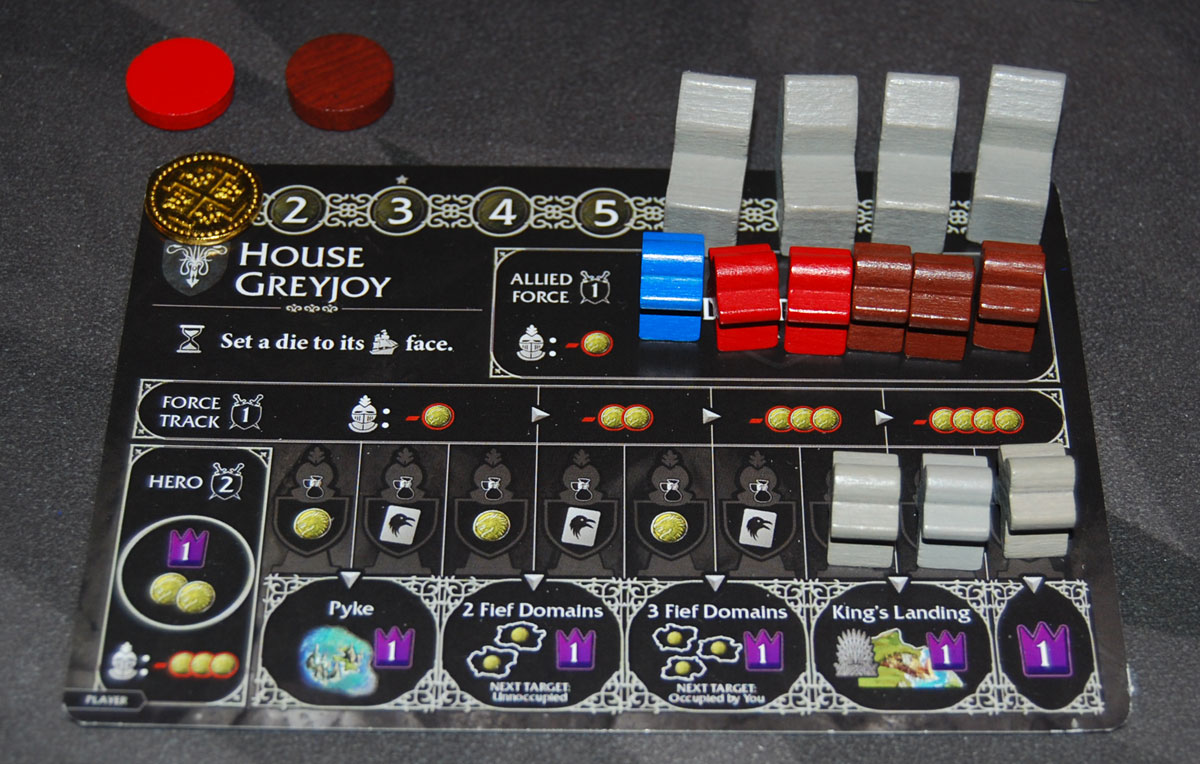
After everyone has had a turn to choose an action die, the round ends and there’s a bit of cleanup. First, this is when you check alliances. If you have at least 2 power tokens of a house and you have more than any other player, then you gain the alliance and take that house’s shield. (In case of a tie, alliances are retained, though if nobody currently has an alliance and there’s a tie, it is broken in turn order.) When you have an alliance, all of that house’s troops and heroes are under your control, and you also have access to that house’s die-manipulation ability. Any castles held by that house now go to your gold track, and you may recruit power tokens and heroes from that house as well as your own.

Next, everyone collects taxes. You gain the things that are currently revealed on your power track: gold and cards. You also gain 1 gold for each fief domain you control—the regions that show a gold coin rather than a castle.
Finally, everyone culls their ally pools—you discard down to 2 power tokens per house, and the rest go back to the non-player house mats.
Advance the crown on the round track, and pass the Hand of the King clockwise.
There are three scoring rounds throughout the game—after round 3, after round 5, and after round 6. When the crown reaches those spaces, you pause and score.
First, players will score points based on who has the most castles. Then, players will score for the scoring objectives at the bottom of their house mat. In order to score, you must fulfill the condition and have recruited all of the power tokens directly above that objective. In the photo above, House Martell will earn 1 point if they still control their home domain of Sunspear, and 1 point if they control at least 2 fief domains. They cannot score for controlling 3 fief domains (or any of the others) because they have not recruited the second power token above that objective.
Whoever is in last place after the scoring round gains the vengeance token from the round track. For each vengeance token you have, you score 1 point when you initiate a battle.
Game End
After the scoring round following round 6, the game ends. The player with the most points wins, with ties broken in this order: Iron Throne, most castles, most recruited power tokens of their own house, most gold. “If there is still a tie, share victory… just sleep with one eye open.”
Ice & Fire Expansion
The Ice & Fire expansion adds two more houses that you can include in regular play: Night’s Watch (with John Snow) and House Targaryen (with Daenarys). Daenarys’ hero card lets you place dragon eggs, which can be hatched into dragons. Dragons provide 2 strength in battle, and can also be flown (during a March or Sail action) to fly over enemy domains, but they travel alone or with only Daenarys.
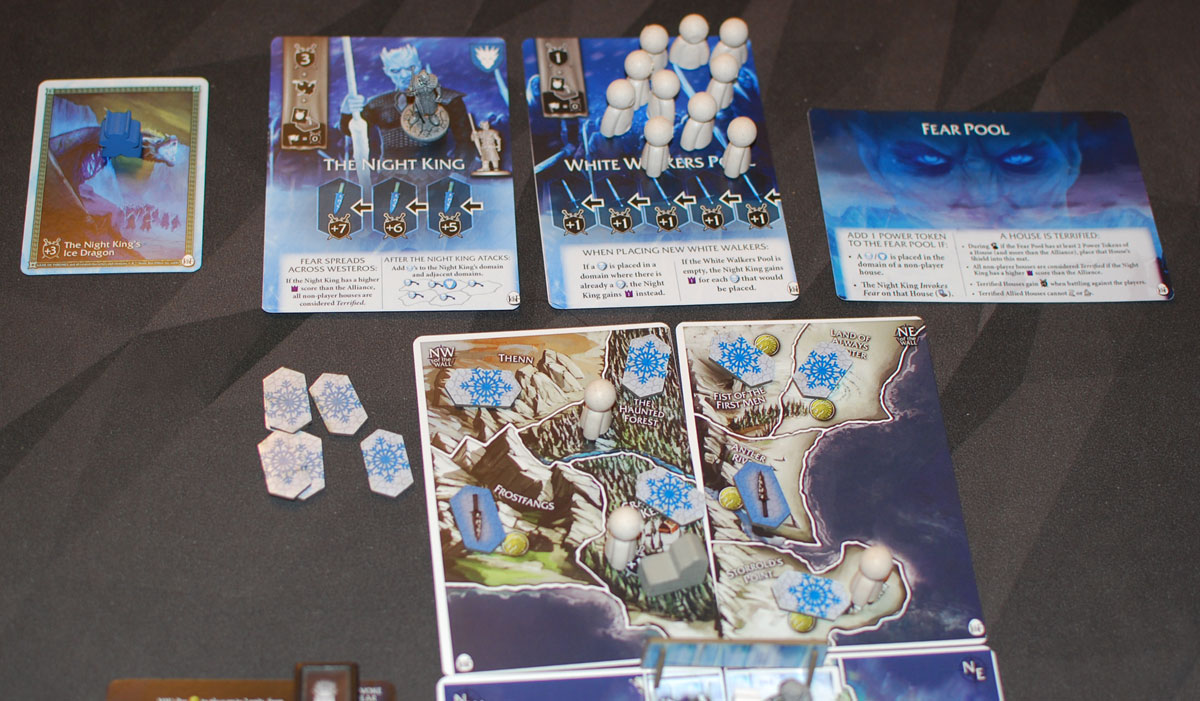
The bigger change that Ice & Fire adds is cooperative mode: all of the players will work together to fight the Night King. There are two more map cards that extend to the north (as well as a cardboard wall standee to place on the border). The board is also seeded with White Walkers north of the wall and some exploration tokens throughout the entire map.
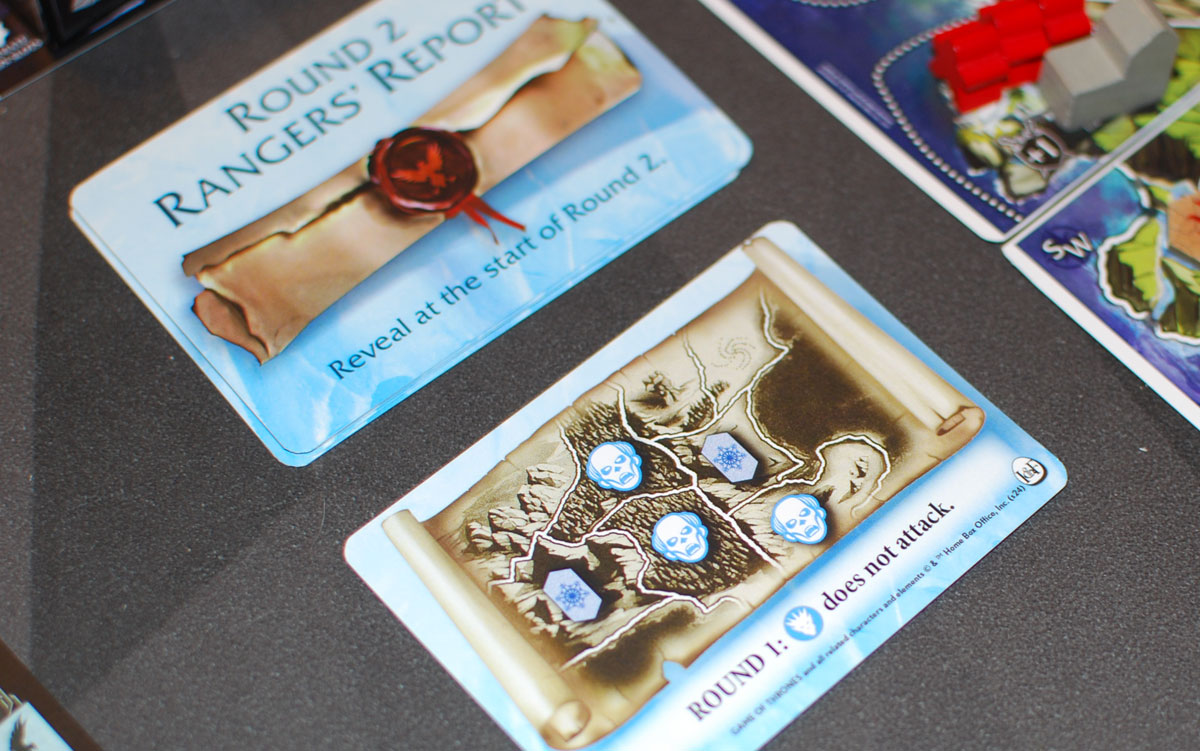
At the beginning of each round, you’ll flip a Rangers Report card that adds White Walkers to the map. It also flips over exploration tokens in the north—some of these will include dragon glass shards that you want to collect, but many of them have negative effects. It also tells you where the Night King attacks—he just shows up, attacks with tremendous strength, and adds a lot more White Walkers. The White Walkers are limited to one per region, and there’s a limited number total as well—if you ever need to add one and you can’t, the Night King gains a point.

In the cooperative game, you don’t win by gaining points, but the score track represents morale. You must have at least as many points as the Night King in order to fight—otherwise, you automatically retreat when he attacks, and you cannot attack him. Your gold resources are shared, as are the power tokens you gain for alliances. Castles no longer reduce your gold, but instead provide points when you score. Meanwhile, the Night King doesn’t form alliances but instead has a Fear mat. If he collects enough power tokens from the other houses where it would normally give an alliance, that house becomes terrified—they have increased strength when they fight you.

To fight the Night King and the White Walkers, you’ll need to find and collect certain tokens: dragon glass is placed on the White King mat to reduce his strength, and Valerian steel is placed on the White Walkers mat to reduce their strength. Without them, the Night King has a starting strength of 21(!) and each White Walker is worth 6 (and then they still add the top card of the deck when they battle). Collecting the brown tokens south of the wall requires moving at least 3 units into a region—besides the steel, there are also tokens that will give you gold, remove White Walkers, or let you peek at the next Rangers Report. Collecting the dragon glass is a trickier issue: each time you attempt it, the Ice Dragon shows up and you’ll have to win a battle in order to collect the glass. After the third dragon glass is picked up, the Ice Dragon travels with the Night King whenever he attacks, making him even stronger.
On top of all this, the Night King will evoke fear after every player turn—the top card is flipped and gain either non-player power tokens or White Walkers to the Fear mat. Power tokens will help the Night King terrify houses, and White Walkers will make the alliance lose power tokens from their ally pool.
You win by defeating the Night King by the end of round 6, otherwise you all lose.

Why You Should Play Tiny Epic Game of Thrones
First, a confession: I actually haven’t read any of the Game of Thrones books or watched any of the TV show. Everything I know about the series is just what I’ve picked up from being on the internet in the past two decades, plus the song “Everybody Dies” by the PDX Broadsides. It’s enough that I recognize references on the cards like “Red Wedding” and “A Crown for a King” but not enough that I’m really familiar with all of the heroes or the particulars of the houses: I recognized about half of the hero names. That said, you really don’t need to know much more about the series to play the game, and I imagine that even more familiarity will give you even more immersion into the world of Westeros.
This is the first of the Tiny Epic titles based on a licensed property, and it also happens to be the most expensive one so far. Most of the other titles have been about $25 for the Kickstarter version, whereas Game of Thrones raises the price to $40. I imagine some of that has to do with everything involved with licensing a big IP like this, but as I mentioned earlier there’s also a lot more stuff packed into this box. This game really shows off the “epic” half of “Tiny Epic”: other than the fact that the map is made up of a series of large cards instead of a folding board, the gameplay (and length) are definitely comparable to many other full-sized games that cost significantly more. (I will note that although the box says it takes an hour, most of my plays have taken closer to 2 hours, with one learning game in particular going much longer.)
One thing I was expecting from a Game of Thrones game was betrayals: I know that a lot of the storyline is about plotting and maneuvering and backstabbing, so I wondered how that would be represented in the game. In this case, the players don’t really make and break alliances among themselves—other players are always considered enemies in terms of movement and battles. (That doesn’t stop you from making meta-game alliances and promises of future actions, of course, but it’s not explicitly part of the game.) Instead, it’s the four non-player houses that come into play, and the players will be vying for the alliances of those houses. There are a lot of advantages to be had in an alliance: for one, you automatically gain castles that your allies control (and you need castles for points!). You also take control of all of their troops on the map, and it’s a lot cheaper to recruit more from your allies than it is from your own house; your costs rise as you recruit more, but an ally’s power tokens are always 1 gold each. Without allies, you’ll never get more than 4 base strength in a battle (one hero and two power tokens)—with an ally, you could double that.
But then, of course, there’s the backstabbing, represented by the loss of an alliance. There are multiple ways that can happen, too. Another player may simply out-plot you and get even more of that house’s tokens into their ally pool by the end of the round. Depending on the plot cards, they can even steal some from you or return some of your ally pool to the mats. Or they could win some fights against you. Because the ally pools get culled back down to 2 per house every round, you can’t rest on your laurels, either. If you don’t keep giving your allies more reasons to stick around, they’ll get bored of you. Losing an alliance can be pretty devastating, especially if it happens right before a scoring round. You have to retreat from every region that you share with a lost ally—you don’t get a chance to battle them. That affects the regions you control, the castles you own, and the objectives you can score for. And if you invested heavily in recruiting from a non-player house instead of your own because it was cheaper, you’ll find yourself sorely outnumbered if you don’t manage to maintain that alliance.
The game is really driven by the action selection: you’re all drafting from the pool of dice, but the last player gets to claim a die first even though it will be played last. You’re trying to plan out which action you want to allow everyone to take with the die (or perhaps you try to deny certain actions for the earlier players). Then, when it’s your turn, you have two dice to choose from for everyone’s action, but there’s also the action mat to take into account. Figuring out your two actions—what’s available, what order you want to do actions in, whether to use your house ability to choose a different die face altogether—is the meat of the game. And, not gonna lie, it can lead to a bit of analysis paralysis if your players are prone to that. If you choose a die because it’ll pair nicely with a particular spot on the action mat, but then somebody takes that spot before you, you might get stuck not being able to afford your die action after all. On the other hand, if you choose a die to guarantee that you’ll get to do something specific, remember that everyone else gets the die ability too! As in some other games with a “follow” mechanic, one tactic is to choose an action that other people can’t or don’t want to do at that time, because that essentially puts you one action ahead. (Of course, they’re trying to do the same thing to you!)
I like that the battles are pretty quick to resolve. There’s not a lot of math, there aren’t any dice, just one card per player at most. Defense is a little harder generally because attackers win ties and playing a card may have a gold cost (though you do get the benefit of strength from castles or the Iron Throne). That means there’s some encouragement from the game to be aggressive, especially when a scoring round is coming up. You want to control the most castles when that crown hits the scoring rounds! But controlling a bunch of castles means you have less money. There was one game where I controlled 6 castles, which meant I could only get up to 3 gold at a time. Since the last two recruits cost 4 gold each, it really stymied my ability to continue expanding. Not only that, other players were able to recruit two units per Recruit action, but I could only get one at a time. I think that’s a really clever way to represent the huge costs of maintaining a hold on so much territory—you need it to score, but it really stretches your resources.
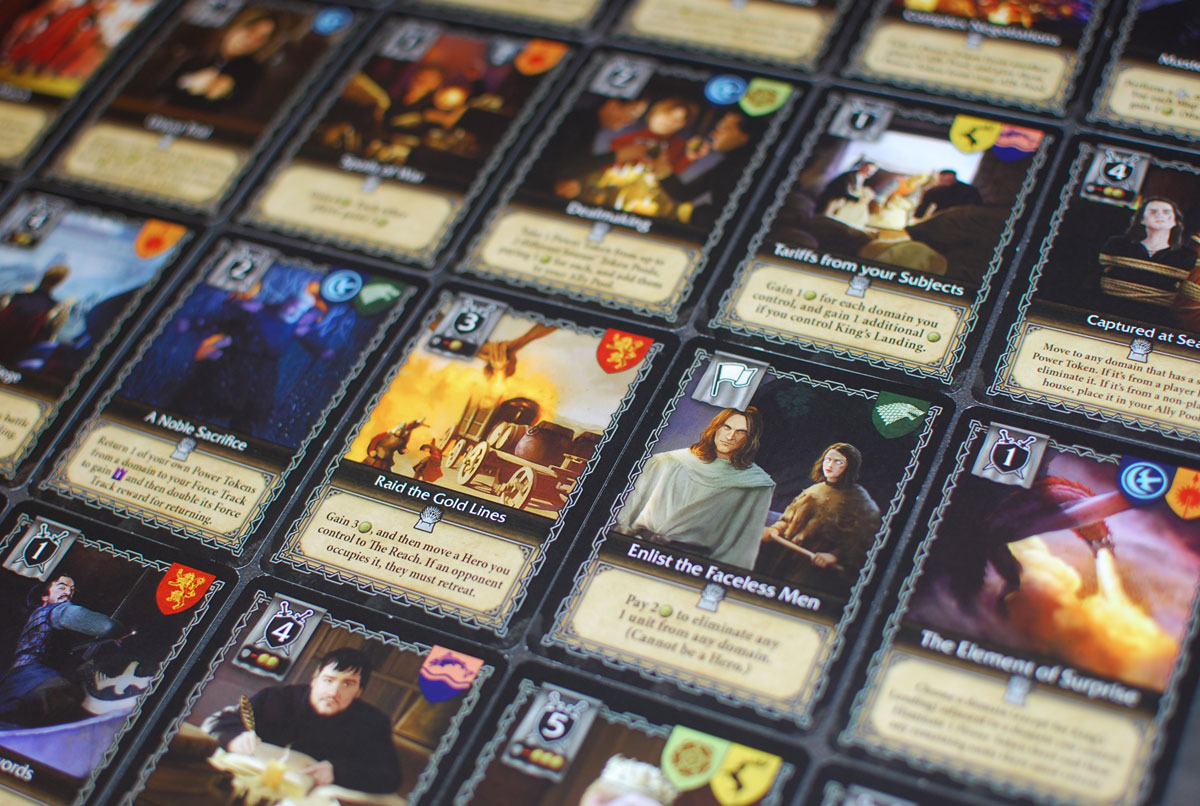
The plot cards and hero cards are a lot of fun, especially the events. There are so many really cool effects and you’ll want to play all of them, but you also need to save some cards if you’re expecting a battle, or to plot to get some alliances, or maybe just to discard for some gold. There are events that will let you start a fight and give you an advantage, and plenty of ways to earn some gold or manipulate alliances by rearranging power tokens.
I did get to try the cooperative mode once (mostly I played the base game), and I enjoyed it as well. I wasn’t sure about a cooperative Game of Thrones given my impression of the story, but the Night King makes for a formidable foe to work against. Early in the game, we started with more morale (at least in the standard setup) so we have the ability to attack the Night King, but it’s impossible to get anywhere near 21 strength at that point. By the time we collected enough dragon glass to bring his base strength down to a reasonable 3, he gained the advantage of the ice dragon, and we were neck and neck on the score track so it was always a gamble whether we’d be able to fight once we got everyone into position. I like that it has much of the same mechanics of the base game in terms of the action dice selection and maneuvering, but gives you a less backstabby option in case your gaming group prefers to work together. Still, it is definitely easier to learn if you’ve already played the base game, because it does add rules on top of the base game. (And Daenarys’ dragons are fun to use, too!)
I will leave it up to Game of Thrones fans to determine whether Tiny Epic Game of Thrones does a good job of telling the story, but I can vouch for the gameplay. It’s a solid area control game with some cool uses of non-player units, and the dice action selection allows for some interesting tactical decisions. The game already looks pretty great even in prototype form, and will be even more striking with the screen-printed custom meeples. If you like the genre of troops-on-a-map battle games, I think it’s definitely worth a look. As a bonus: whether you liked the way the TV series ended or not, Tiny Epic Game of Thrones gives you a chance to write your own ending, again and again!
For more information or to make a pledge, visit the Tiny Epic Game of Thrones Kickstarter page!
Click here to see all our tabletop game reviews.
![]() To subscribe to GeekDad’s tabletop gaming coverage, please copy this link and add it to your RSS reader.
To subscribe to GeekDad’s tabletop gaming coverage, please copy this link and add it to your RSS reader.
Disclosure: GeekDad received a prototype of this game for review purposes.
